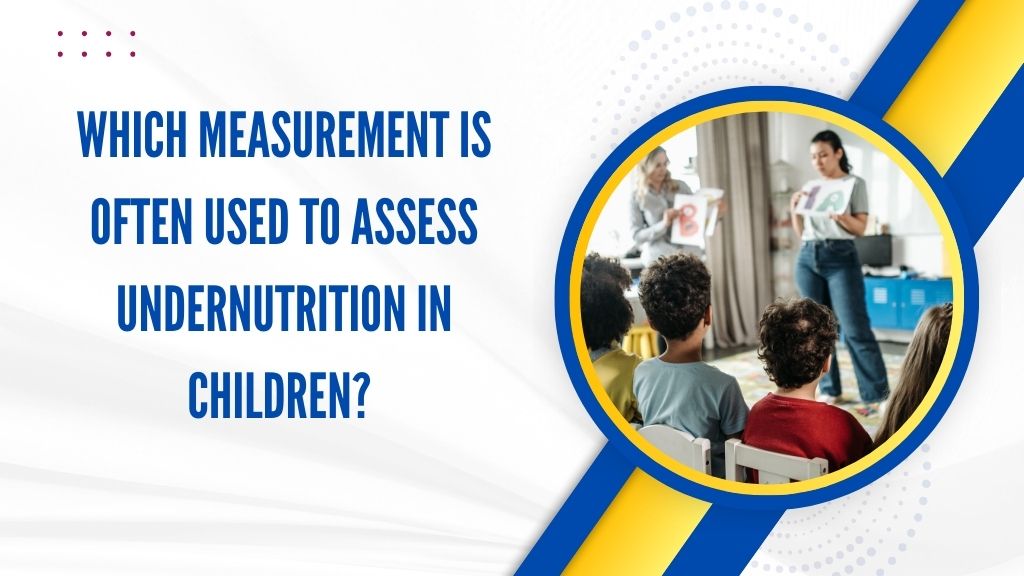Which measurement is often used to assess undernutrition in children? This is a crucial question in the field of public health and child nutrition. Undernutrition is a serious issue that affects millions of children worldwide, leading to poor growth, weakened immunity, and increased risk of infections. Proper assessment of undernutrition is essential to identify affected children and provide them with the necessary interventions. Various measurements are used to evaluate undernutrition in children, including weight-for-age, height-for-age, weight-for-height, and mid-upper arm circumference (MUAC).
In this blog, we will discuss these measurements in detail, their significance, and how they help in determining the nutritional status of children effectively.
Understanding Undernutrition in Children
Undernutrition occurs when a child does not receive adequate nutrients required for proper growth and development. It is categorized into different types, including:
- Wasting: A child with low weight compared to their height.
- Stunting: A child with low height compared to their age.
- Underweight: A child with low weight compared to their age.
- Micronutrient Deficiencies: A lack of essential vitamins and minerals.
Each type of undernutrition has its unique characteristics and health risks. Accurate measurement is necessary to detect and treat undernutrition effectively.
Also read: Why Should We Help People in School Who Are Different From Us?
Which Measurement is Often Used to Assess Undernutrition in Children?
There are several key measurements used to assess undernutrition in children. These include:
1. Weight-for-Age
Weight-for-age is a simple measurement that compares a child’s weight with the standard weight for their age. It helps in identifying underweight children. However, this measurement alone cannot distinguish between stunting and wasting, so it is often used in combination with other indicators.
Advantages:
- Easy to measure using a weighing scale.
- Useful for identifying children with general malnutrition.
Limitations:
- Cannot differentiate between short-term and long-term malnutrition.
2. Height-for-Age
Height-for-age measurement helps in assessing stunting, which occurs due to long-term undernutrition. A child is considered stunted if their height is significantly lower than the standard height for their age.
Advantages:
- Useful for identifying chronic undernutrition.
- Indicates long-term effects of poor nutrition.
Limitations:
- Requires precise measurement tools like a stadiometer.
- Does not detect short-term malnutrition.
3. Weight-for-Height
Weight-for-height measurement helps in identifying wasting, which is a sign of acute malnutrition. A child with low weight compared to their height is considered wasted.
Advantages:
- Effective in detecting recent weight loss.
- Helpful in emergency situations to identify children at immediate risk.
Limitations:
- Requires accurate weight and height measurement tools.
- May not indicate long-term nutritional issues.
4. Mid-Upper Arm Circumference (MUAC)
MUAC is a widely used and simple method to assess undernutrition, especially in field settings. It involves measuring the circumference of a child’s upper arm using a special measuring tape.
Advantages:
- Quick and easy to use.
- Effective for identifying severe acute malnutrition.
- Does not require complex tools.
Limitations:
- Less precise than other methods.
- May not capture all types of undernutrition.
Importance of Early Detection of Undernutrition
Early detection of undernutrition is essential for preventing severe health complications. Children suffering from undernutrition are at risk of:
- Weakened Immunity: Making them prone to infections.
- Delayed Development: Affecting cognitive and physical growth.
- Increased Mortality Risk: Severe undernutrition can be life-threatening.
Health professionals, caregivers, and community workers must regularly monitor children’s growth using appropriate measurements to ensure timely interventions.
Role of Growth Monitoring Charts
Growth monitoring charts help in tracking a child’s growth over time. The World Health Organization (WHO) Growth Standards and CDC Growth Charts are widely used for this purpose. These charts allow healthcare providers to:
- Compare a child’s growth with standard reference values.
- Identify any signs of undernutrition early.
- Provide necessary dietary and medical interventions.
How Governments and Organizations Address Undernutrition
Several global organizations and governments work to reduce child undernutrition through various programs, such as:
- UNICEF’s Nutrition Programs: Providing food supplements and health services.
- World Food Programme (WFP): Delivering nutritious meals to malnourished children.
- National Health Initiatives: Many countries have programs to improve child nutrition through awareness campaigns and healthcare services.
Preventive Measures to Reduce Undernutrition
To prevent undernutrition, it is important to take proactive steps, including:
1. Ensuring Proper Infant Nutrition
- Exclusive breastfeeding for the first six months.
- Providing adequate complementary foods after six months.
2. Balanced Diet
- Including protein-rich foods like eggs, milk, and fish.
- Ensuring sufficient intake of fruits, vegetables, and whole grains.
3. Improving Hygiene and Sanitation
- Providing clean drinking water.
- Promoting proper handwashing practices.
4. Regular Health Checkups
- Monitoring a child’s growth using the mentioned measurements.
- Timely vaccination to prevent infections.
5. Community Awareness Programs
- Educating parents about the importance of proper nutrition.
- Encouraging breastfeeding and healthy eating habits.
Conclusion
Which measurement is often used to assess undernutrition in children? Several key measurements, including weight-for-age, height-for-age, weight-for-height, and mid-upper arm circumference (MUAC), help in identifying undernutrition in children. These methods play a vital role in early detection and intervention, preventing severe health complications. Regular growth monitoring, proper nutrition, and government initiatives are essential in addressing child undernutrition. By understanding and using these measurements effectively, healthcare providers and caregivers can work towards ensuring a healthier future for children worldwide.

